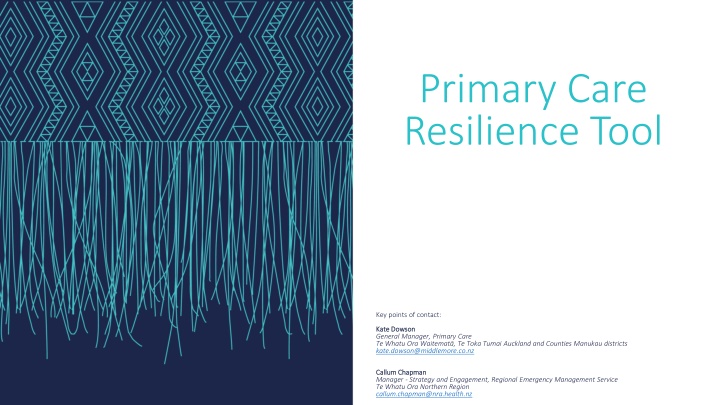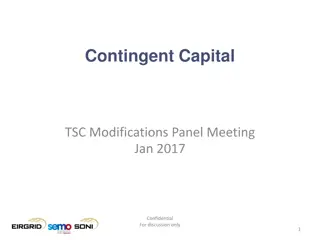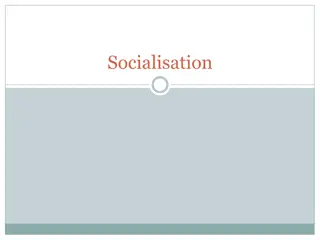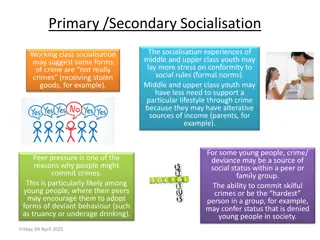
Primary Care Resilience Tool and Dashboard Overview
Discover the Primary Care Resilience Tool, a vital resource for ensuring effective communication and coordination among primary and community care providers. Learn how this tool facilitates real-time updates on service statuses, wait times, workforce pressures, and more to enhance system resilience during emergencies and everyday operations.
Download Presentation

Please find below an Image/Link to download the presentation.
The content on the website is provided AS IS for your information and personal use only. It may not be sold, licensed, or shared on other websites without obtaining consent from the author. If you encounter any issues during the download, it is possible that the publisher has removed the file from their server.
You are allowed to download the files provided on this website for personal or commercial use, subject to the condition that they are used lawfully. All files are the property of their respective owners.
The content on the website is provided AS IS for your information and personal use only. It may not be sold, licensed, or shared on other websites without obtaining consent from the author.
E N D
Presentation Transcript
Primary Care Resilience Tool Key points of contact: Kate Dowson Kate Dowson General Manager, Primary Care Te Whatu Ora Waitemat , Te Toka Tumai Auckland and Counties Manukau districts kate.dowson@middlemore.co.nz Callum Chapman Callum Chapman Manager - Strategy and Engagement, Regional Emergency Management Service Te Whatu Ora Northern Region callum.chapman@nra.health.nz
Whats the gap? Hospital and specialist services can communicate their demand and capacity using real-time quantitative data. Primary and community care services don t have the same. Primary and community care has many disparate providers that are privately owned. Challenges for local providers to share information. Limited on the ground intelligence collected systematically = hard to understand system pressures either for BAU or in an emergency response.
What is the Primary Care Resilience Tool? For each Practice/Clinic/Pharmacy/Service: Open or closed Overall status (red, amber, green) (incl. partially closed or virtual only) Approximate wait times (GP and UCC only) (third next available appointment for routine and urgent + virtual and walk in) Workforce pressures (clinical and non-clinical staffing levels) Resource pressures (critical supplies, IT, infrastructure) Free text (direct comments and feedback)
Primary Care Resilience Tool Dashboard Region: Region: Northern Period: Period: Sample report General Practice and Urgent Care General Practice and Urgent Care 4 4
Primary Care Resilience Tool Dashboard Region: Region: Northern Period: Period: Sample report General Practice and Urgent Care General Practice and Urgent Care 5 5
Timeline Developed a new tool in conjunction with PHOs in preparation for Delta outbreak Developed long term strategy Engagement with Home and Community Support Services Enhancements made to the tool questions added around clinic wait times and staffing levels Added pharmacies Review of a previous tool used during 2020 COVID-19 outbreak Northland scoped for inclusion Delta Outbreak (August) Omicron Outbreak (January) Launched first version (August) 2023 Launched PCRT 2.0 (November) 2022 2021
So what? On the ground primary and community care intelligence gathering Collective ways of working Stating a case for change Informed decision making at all levels Strengthening collective ways of working between services, PHOs and Te Whatu Ora and Te Aka Whai Ora. We can ensure care is delivered where it s most needed equity approach. Data informed timely decision- making. Sharing pressures regionally and nationally to inform policy. Local providers able to share pressures with nearby health services. Local ways of working to manage pressures together. Aggregated information about primary care pressures. Data can be compared with secondary care reporting. Building an understanding of primary care - telling the story .
Next Steps Next 3 6 Months Future Scope Data Integration Scope other data sets that can be incorporated into the tool (such as secondary care data sets) Aged Residential Care Development of an ARC dashboard which includes vacancy status reporting. Home and Community Support Services Development of a pilot in the Northern Region for Home and Community Support Providers. Provider input enhancements - This involves enhancing M ori and Pacific provider inputs and dashboard views. National Rollout Making the current version of the PCRT available to all General Practices, Urgent Care Clinics and Pharmacies across Aotearoa. Expansion of services This involves extending the tool to additional community services such as telehealth providers and ambulance providers. Ongoing enhancements - This involves the ongoing enhancement of the question sets and technical functionality of the tool. Formalise Data and Digital support for the Primary Care Resilience Tool. Emergency Management Integration - This involves adding Emergency Management information layers to the tool. Integrated Dashboard Develop an integrated dashboard across services.
Appendix One: Test site login details resiliencetool.i3-uat.nz username: TeWhatuOra password: an0therPWD!





